At Your Boxes:
Tree Swallows have been present, claiming boxes and courting for weeks. But it’s certainly taking a long time for nest building to start, isn’t it? Bits of vegetation appeared in boxes early in site-claiming. But then there was a pause, a long pause, wasn’t there? However, box checks now reveal Tree Swallow nest building has finally begun in earnest.
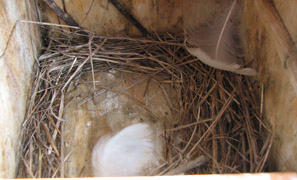
Concepts:
Why do birds spend time and energy making nests? What’s a nest’s purpose?
- Nests can contain and confine eggs and young in one place so they won’t fall out or get lost.
- A nest’s bowl-like structure clusters eggs and young together so they can be incubated and brooded efficiently.
- Nests help protect and insulate eggs and young from wind, cold, and damp that could conduct heat away.
Why did it take Tree Swallows so long to start nest building?
- Tree Swallow arrival, site claiming, and pair formation take place while it’s often still cold. Many other migrant species won’t be back for another month or more. See Tree Swallow Spring Return.
- Early arriving swallows won’t be laying eggs right away so maybe they don’t need to hurry to build nests. (For late-nesters it’s a different story, as we’ll see).
What nest material do you see in boxes and see swallows bringing? Describe a nest.
- There’s usually a base with a shallow cup, both made of dead dry grasses and plant stems, or occasionally pine needles. They don’t use sticks or twigs.
- In completed nests feathers, usually white, are placed to line and arch over the cup.
Where are the swallows getting their nest vegetation?
- They gather most of it from the ground within sight of the cavity.
- Photo below by Kathy Habgood.

How does a Tree Swallow collect the vegetation?
- A swallow flies low, looking down, then drops to the ground.
- It picks a piece of vegetation in its bill, tugging it loose with flapping wings if necessary.
- Then it flies back to its cavity carrying the vegetation in its bill.
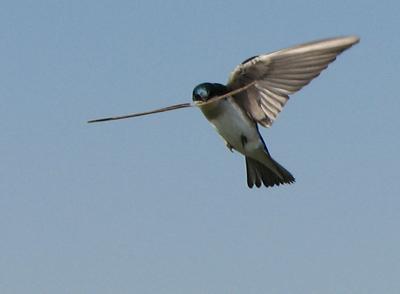
- Landing at entrance holes with nest material and manipulating it into boxes can be difficult. They often drop large unwieldy pieces.
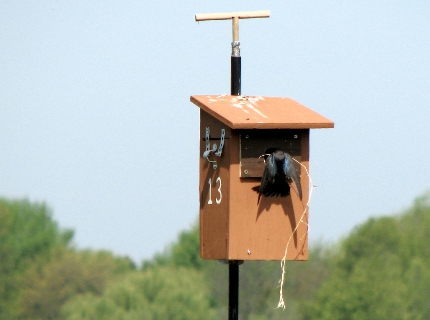
How do swallows move on the ground as they gather nest material?
- Awkwardly. They may flop along using wings for balance.
- Their legs are very short and not well-adapted for walking or hopping.
What is a usual sequence of Tree Swallow nest building?
- Bits of vegetation appear during box claiming.
- A slight ring forms around the box floor (top left, below).
- The ring becomes more obvious as the swallow adds more vegetation (top right, below).
- The base thickens and the cup becomes obvious. Box bottoms may still show (bottom left, below).
- Feathers, some quite large, are added gradually.
- Completed Tree Swallow nests usually have full cups with feathers surrounding and arching over the cups (bottom right, below). Some nests have many more feathers than the one shown. Some have few or none at all.
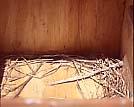
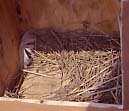
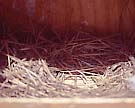

- You will probably see nests with cups located in the back middle or back corners rather in the center, as in the photo below. We think this makes it harder for predators to reach eggs, young or parents.
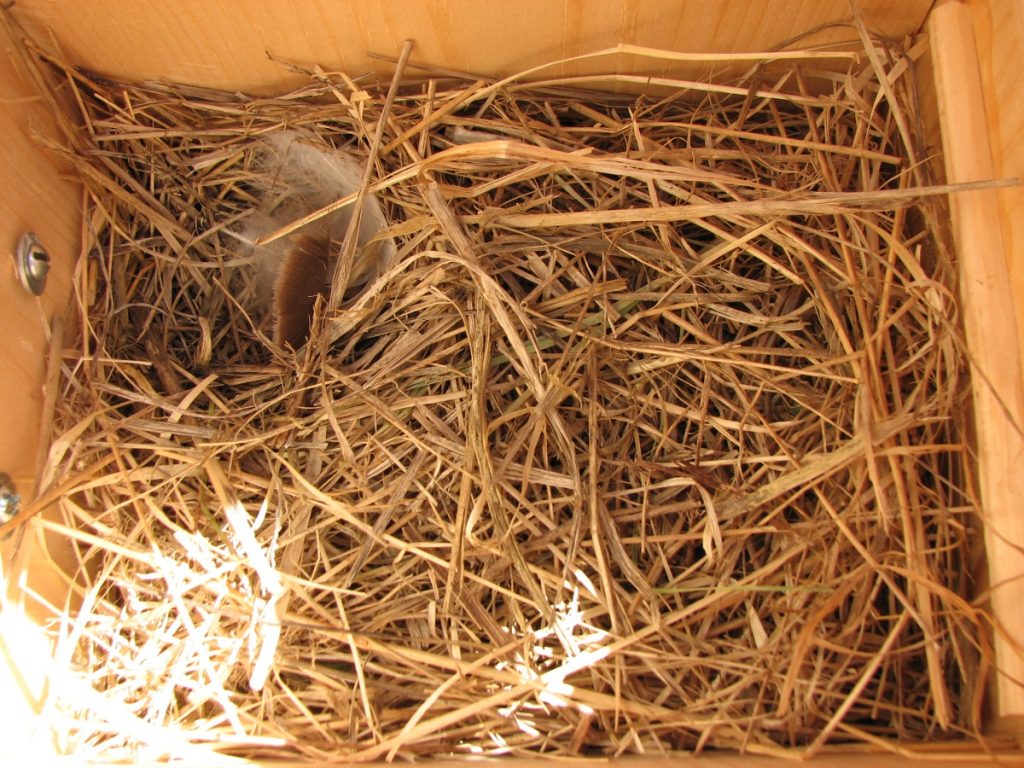
- Here’s a YouTube video from Francois Paquette’s in-box camera in Quebec. It shows one female Tree Swallow building her nest of plant material. Her technique may surprise you!
How long does Tree Swallow nest building take once it has really begun?
- One to two weeks is average, but we’ve found placing dried grasses (see below) on the ground beneath the box helps females by shortening search time required.
- The swallows add feathers as they find them for several additional weeks.
- Late season nests may be skimpier and built in just a few days.
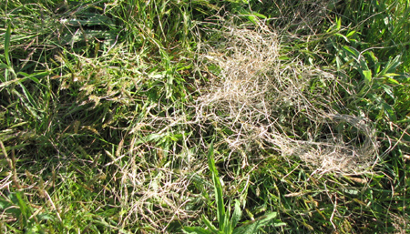
Who builds nests, males, females, or both?
- In our experience females bring all the plant material.
- Both males and females bring feathers.
- Female Tree Swallows do the actual nest building, arranging the vegetation and feathers.
- Females shape the cup, pushing and compacting nest vegetation with their breasts.
- Many other songbirds have similar divisions of labor by sex.
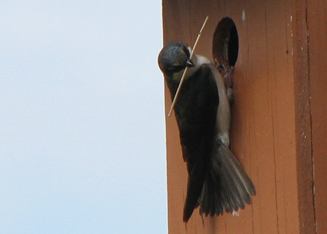
What do males do while females gather vegetation?
- Males often stay at the box guarding it, while females come and go gathering vegetation. They don’t accompany females collecting nest material.
- Males typically give a soft “Gurgle” call as females bring material and while females are inside the box nest building. (See Tree Swallow Song and Calls). It’s believed this call helps stimulate female nest building and strengthens the pair bond.
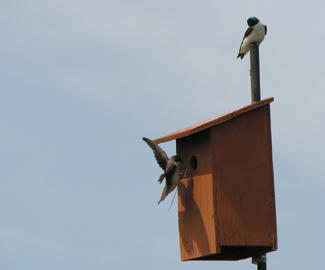
- Perhaps the most important way male Tree Swallows contribute to nest building is by searching for feathers and bringing them into the nest cavity.
- Watch Francois Paquette’s male and female Tree Swallows bring feathers, and observe how they handle the feathers once inside their box.
What’s the purpose of the feathers Tree Swallows use in nest building?
- Research has shown that well-feathered nests cool off much slower than nests with few or no feathers, keeping eggs and young warmer during times when the female swallow must be away.
- Nestlings in well-feathered, well-insulated nests could therefore use more of their energy for growth and development and spend less trying to stay warm.
- A warmer nest with warmer eggs or young may also let adults spend more time away gathering food.
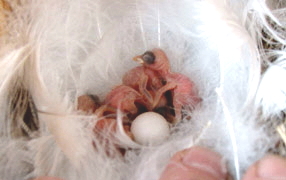
- Feathers might also help hide eggs and young from predators.
- Feathers may inhibit ectoparasites in some way.
- It’s possible feathers protect nestlings from being cut or scratched by the ends of coarse nest vegetation.
- Whatever the reason or combination of reasons, Tree Swallow nestlings have been found to grow larger and faster, and to survive to fledging more often in nests well-lined with feathers, so these feathers are a valuable resource.
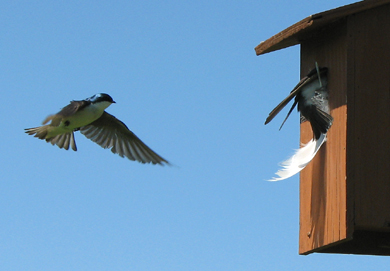
Why do Tree Swallows prefer white feathers?
- We aren’t sure. It’s possible they make swallows’ pure white eggs less visible to predators.
Where do swallows get the feathers? Can you identify what species the feathers in your boxes came from?
- Since Tree Swallows often nest in or near wetlands, waterfowl and gulls are common feather sources. Our own swallows prefer white Mute Swan feathers (see below) but also use Canada Goose and Mallard Duck feathers.
- If necessary Tree Swallows will fly several miles to get suitable feathers.
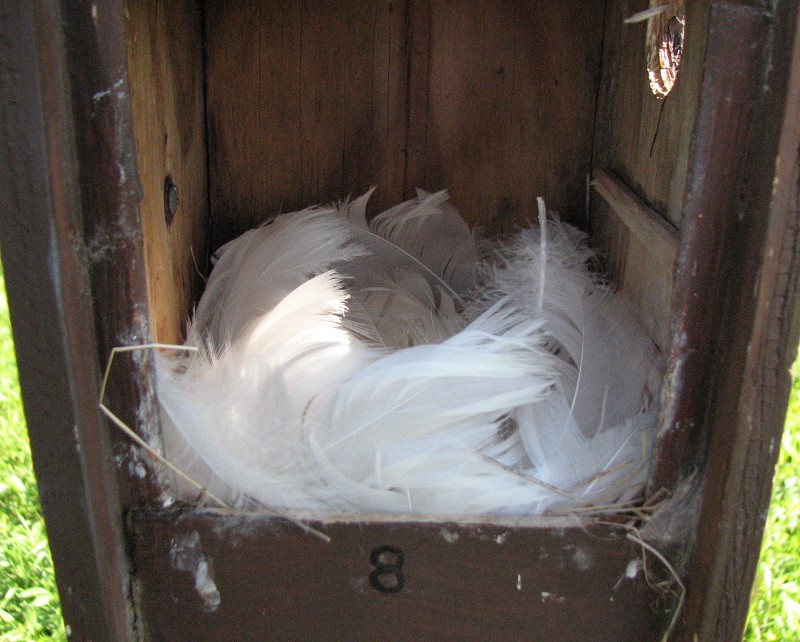
What happens when a swallow arrives carrying a feather?
- Other swallows may give chase and try to steal it for their own nests.
- Pursuers call loudly, which may draw a crowd of additional chasers.
- Battles often ensue before one bird finally is able to get the feather into its nest.
- Photo below by Euan Reid.
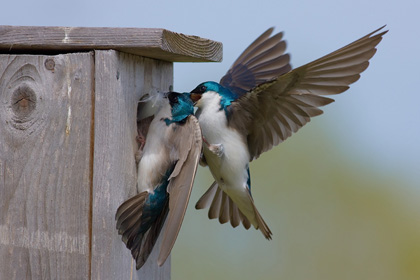
- Try bringing white feathers to your project. Throw some up, and watch the commotion that follows. Include a few large ones that require real skill to carry and maneuver through the entrance hole into the nest.
- Watch this amazing YouTube video to see how eager Tree Swallows can be to get white feathers!
Questions for the next Topic: Bird Flight shown by Tree Swallows.
- How are birds’ bodies different from ours?
- How are these differences related to a bird’s ability to fly?
- What can’t a bird do with its wings?
- How does a bird change the shape of its wings and positions of its feathers during flight in order to push down a large wing and raise up a small wing?
—————————————————————————–
Home: Tree Swallow Nest Box Projects
Creating Tree Swallow Nest Box Projects
Spring Return
Nesting Season Behavior
Song and Calls
Nest Site Claiming
Pair Formation
Nest Building
Bird Flight
Mating and Paternity
Diary of One Season at Salmon Creek
Monitoring Nest Boxes and Keeping Records
Making Box Checks Keeping Box Records Control Sheets Season Summaries Print Sheets
Banding Your Tree Swallows Banding Adults Banding Nestlings
Tree Swallows in Research Research Bibliography Glossary of Terms